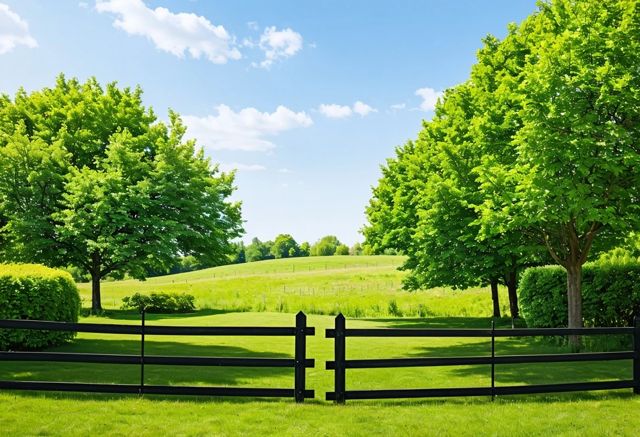Cedar fences offer natural beauty, durability, and low maintenance but come with higher upfront costs. Pressure-treated wood fences are more affordable initially and versatile in design but require more upkeep and come with potential environmental concerns.
Introduction to Fence Materials
When selecting materials for fencing, pressure-treated yellow pine and cedar wood are popular choices. These materials are favored for their unique properties that cater to different needs and preferences.
Cedar Fences:
- Natural beauty with rich tones and distinctive grain patterns
- Built-in resistance to rot, decay, and insects due to natural oils
- Longevity of up to 40 years with minimal maintenance
- Excellent dimensional stability, resisting warping and twisting
- Pleasant aroma and eco-friendly when sourced responsibly
Pressure-Treated Wood Fences:
- Typically made from Southern Yellow Pine, which undergoes chemical treatments to resist rot and insects
- Lower upfront cost compared to cedar
- Can be stained or painted for design flexibility
- Requires regular maintenance to maintain appearance and protection
- More prone to warping and twisting over time compared to cedar
Comparison Highlights:
- Aesthetics: Cedar’s natural look is more appealing, while pressure-treated wood offers customizable options through stains and paints.
- Cost: Pressure-treated wood is cheaper initially but has higher long-term upkeep costs. Cedar costs more upfront but is a better investment over time due to its durability and low maintenance. For more about choosing the right wood for fences, check out our detailed guide.
- Durability: Cedar naturally resists damaging elements better than pressure-treated wood.
- Environmental Impact: Cedar is more eco-friendly due to its natural properties, whereas pressure-treated wood involves chemical treatments.
Overall, pressure-treated wood is budget-friendly and versatile, but cedar stands out for its beauty, durability, low upkeep, and environmentally conscious attributes.

Cost Analysis
When comparing the costs of pressure-treated yellow pine and cedar wood for fencing, it’s crucial to consider several factors: initial purchase price, maintenance costs, and overall long-term value.
- Initial Purchase Price: Pressure-treated yellow pine is generally more affordable than cedar. This makes it a popular choice for budget-conscious homeowners.
- Cedar Wood Costs: Cedar is typically more expensive upfront. However, its natural resistance to pests and decay can offset the initial investment over time.
Maintenance Costs
- Pressure-Treated Yellow Pine: Requires regular maintenance to prevent warping and rotting. This includes annual sealing and staining.
- Cedar Fences: Lower maintenance compared to pressure-treated wood. Cedar fences need occasional staining and minor repairs, but they naturally resist weather damage better.
Long-Term Value
- Durability: Cedar fences tend to last longer with proper care, offering better long-term value despite higher initial costs. Explore more on maximizing fencing durability to ensure the longevity of your investment.
- Aesthetic Appeal: Cedar’s natural look can enhance property value. While pressure-treated wood can be painted or stained, it doesn’t match cedar’s natural beauty.
In summary, while pressure-treated yellow pine offers a lower initial cost, cedar provides longer-lasting beauty and durability with less maintenance. The choice ultimately depends on your budget and long-term fencing goals.
Durability and Longevity
When it comes to durability, pressure-treated yellow pine and cedar have distinct characteristics. Pressure-treated wood is chemically treated to resist rot and decay, making it a robust option for areas prone to moisture.
- Pressure-Treated Yellow Pine:
- Rot Resistance: High due to chemical treatments.
- Insect Damage: Resistant because of the treatment.
- Weather Conditions: Tends to warp or crack under extreme weather but is durable in humid conditions.
Cedar, on the other hand, is a naturally durable wood. It contains natural oils that make it resistant to decay and insects without the need for chemical treatments.
- Cedar:
- Rot Resistance: Naturally high due to oils.
- Insect Damage: Naturally resistant.
- Weather Conditions: Less likely to warp or crack, making it more stable over time. Learn more about choosing the right wood fence for your specific needs.
Both materials offer excellent longevity but cater to different needs. Choose based on the specific environment and maintenance willingness.

Aesthetic Appeal and Environmental Impact
When choosing between pressure-treated wood and cedar for fences, their aesthetic appeal plays a significant role. Cedar is known for its rich, reddish hue and tight, attractive grain that gives a natural, timeless look. Over time, cedar ages gracefully into a silver-gray patina, which many homeowners find appealing. On the other hand, pressure-treated wood typically starts with a greenish tint but can be painted or stained in virtually any color, allowing for more customization.
- Cedar:
- Natural, rich reddish hue
- Tight, attractive grain
- Ages into a silver-gray patina
- Pressure-Treated:
- Starts green, can be painted or stained
- Wide range of color options
- Often has a more uniform look
From an environmental standpoint, cedar fences are generally more sustainable. Cedar is a natural wood that’s often harvested from sustainably managed forests. It doesn’t require chemicals to preserve its lifespan, making it an eco-friendly choice for fencing. For those interested in sustainable options, consider exploring our eco-friendly wood fencing options.
Pressure-treated wood, however, undergoes a chemical process to resist decay and pests, which raises environmental concerns. These chemicals can potentially leach into the ground over time, posing a risk to the surrounding environment. Though pressure-treated wood has a long lifespan, its environmental footprint is higher compared to cedar.
- Cedar:
- Sourced from sustainably managed forests
- Chemical-free preservation
- Pressure-Treated:
- Chemical treatment to resist decay and pests
- Potential environmental impact due to chemical leaching
- Higher overall environmental footprint
For those considering the environmental impact and aesthetic appeal of each wood type, cedar offers a more natural look and an eco-friendly option, while pressure-treated wood provides more versatility in color choices but comes with environmental trade-offs.
For more information on wood fences, expert craftsmanship, and fencing solutions, please visit our services page.

FAQ
What are the main differences between cedar and pressure-treated wood for fences?
Cedar offers natural beauty, rich tones, and distinctive grain patterns with built-in resistance to rot, decay, and insects due to its natural oils. It has excellent dimensional stability and can last up to 40 years with minimal maintenance. Pressure-treated wood, typically made from Southern Yellow Pine, undergoes chemical treatments to resist rot and insects, has a lower upfront cost but requires regular maintenance and is more prone to warping and twisting over time.
Which fencing material is more cost-effective over time?
While pressure-treated wood is cheaper initially, it has higher long-term upkeep costs due to regular maintenance requirements. Cedar, though more expensive upfront, proves to be a better investment over time because of its durability and low maintenance needs.
How does the durability of cedar compare to that of pressure-treated wood?
Cedar naturally resists damaging elements better due to its natural oils, making it highly resistant to rot and insect damage without needing chemical treatments. Pressure-treated wood is robust and chemically treated to resist rot and insects but tends to warp or crack under extreme weather conditions.
What is the environmental impact of using cedar vs. pressure-treated wood for fencing?
Cedar is more eco-friendly as it is a natural wood often harvested from sustainably managed forests and does not require chemical preservation. Pressure-treated wood has a higher environmental footprint due to the chemicals used in its treatment, which can potentially leach into the ground over time.
How do the aesthetic qualities of cedar and pressure-treated wood differ?
Cedar has a rich, reddish hue with an attractive grain that ages gracefully into a silver-gray patina. In contrast, pressure-treated wood starts with a greenish tint but can be painted or stained in various colors, allowing for more customization. Cedar provides a more natural and timeless look, while pressure-treated wood offers a more uniform appearance with flexible design options.

